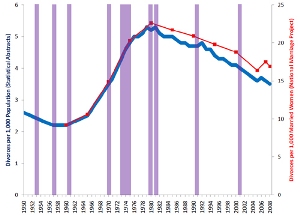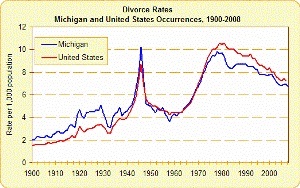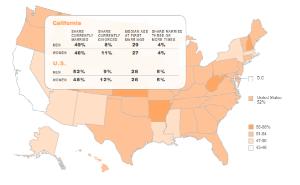Divorce
CALL US TODAY (231) 929-7744
Divorce – General Information

Depending on your circumstances, you may wish to consider alternatives to divorce – marriage counseling, annulment or separation.
Many couples try counseling from a marriage counselor, social worker or psychotherapist as an alternative to divorce. Such counselors are trained to help couples resolve differences. The counselor may be able to help you and your spouse learn communication skills and a better understanding of one another to prevent your marriage from failing. Marriage counseling can be useful when couples find their problems have begun to affect their compatibility with each other. Counseling may also keep a relationship with your spouse from worsening even if divorce is unavoidable.
An annulment is a court ruling that a marriage was never legally valid. A marriage can only be annulled if there was serious defect at the time of the marriage ceremony. In most states, marriages can be annulled if one of the parties was under age at the time of the marriage, if a spouse could not consummate the marriage, if consent was obtained fraudulently, or if the marriage was bigamous or incestuous. People also may seek annulments for religious reasons or because marriage caused a party to lose spousal support from an earlier marriage. Issues of child custody or property division may also be addressed by the court as part of the proceeding.
If you and your spouse separate, it may be best to enter into a separation agreement or obtain a court order of separation. A separation agreement is a contract between you and your spouse that can provide for spousal support, child custody, visitation rights and a division of the property acquired during the marriage. The agreement can be enforced by courts if a party does not comply. If the parties later divorce, it may be included in the divorce judgment.
Common grounds for a fault divorce are adultery, bigamy, cruelty, desertion, incest and insanity. In addition, many states, including Michigan, have adopted “no fault” divorce laws that allow divorce without showing that one spouse was at fault. In Michigan, a divorce can frequently be obtained because of incompatibility of irreconcilable differences or if a spouses live apart for a period of time – often one year.
In certain circumstances, a fault divorce may offer a better legal strategy for you. Our office can guide you on the best way to proceed.

A Michigan divorce case begins with the filing of the Complaint for Divorce (“Complaint”) and a Summons (a form required by the State to start any civil action) also to be filed with the Court. The party who files the Complaint is called the “Plaintiff”, the other party is called the “Defendant”. The current filing fee for Divorce in Michigan is $150.00, plus an additional fee of $80 if the parties have a minor child or children together.
Sometimes, the Plaintiff will also have ex parte (pronounced x-par-tay) orders entered by the Court along with the Complaint. An ex parte order is an order that is signed by the judge without a hearing, based upon the allegations made in a written document, in this case, the Complaint. The types of ex parte orders that may be entered with a new divorce case relate to custody, child support, restraining orders on transferring of assets, or interim orders keeping the status quo. Since an ex parte order is entered by the Court without a hearing, the Defendant has an opportunity to object to the ex parte order within fourteen (14) days from receipt of the order.
- having a process server serve the Defendant, or
- by certified mail/restricted delivery or
- having the Defendant acknowledge service by signing the back of the summons so that it can be filed with the Court.
An Answer is a written pleading, filed with the Court and the Plaintiff’s attorney, which responds to each of the allegations made in the Complaint. If the Defendant fails to timely file an Answer with the Court, the Plaintiff can ask that a “default” be entered. A default is where the Court allows a Judgment to be entered without the consent of the Defendant because the Defendant has failed to respond. If a default is entered, a case can proceed without the Defendant and a “Default Judgment of Divorce” that complies with all applicable statutes and court rules can be entered with the Court, which would essentially end the case.
Unfortunately, most cases are not that simple. In most cases, the Defendant either files an answer or appears at a hearing in the case and the case proceeds with negotiation towards settling the case.
If both parties agree to all the terms of the divorce, including custody, child support, spousal support and property division, a “Consent Judgment of Divorce” that complies with all applicable statutes and court rules can be entered with the Court when the proper waiting period has passed.
Unfortunately, most cases are more complicated than that. In most Michigan divorce cases, there are at least some contested issues. Contesting a divorce in Michigan involves mediation and possibly a trial. If the parties do not agree as to the assets and debts of the marriage, or the values of the assets and debts, discovery will have to be done. Discovery is a process for obtaining information, by such means as interrogatories, depositions or subpoenas. The purpose of discovery is for each party to find out information about the other party. Once that information is obtained, the parties may then try to negotiate a settlement again.

If the Plaintiff and Defendant still disagree on how to settle their case, the Court will still encourage settlement and require that the parties attend mediation. Sometimes, parties will try to settle a case without formal mediation, by having an informal meeting with just the parties and their attorneys. If this is not an option, then formal mediation is the next step. Formal mediation is a process where a neutral attorney is appointed to hear both sides of the story and recommend a resolution. Generally the Plaintiff’s attorney and the Defendant’s attorney agree upon who will be appointed to mediate the case. If the attorneys cannot agree upon a mediator, then the judge will appoint one.
Formal mediation can be costly. The Plaintiff and Defendant pay the mediator hourly for his/her time. In addition, the Plaintiff and the Defendant will be paying their own attorneys for their time to prepare for the mediation and attend the mediation. Preparing for the mediation includes drafting a “mediation summary”. Prior to attending mediation, each attorney submits a mediation summary to the mediator. The mediation summary provides the mediator with an outline of the case and that party’s version on how the case should be settled.
The mediator will read each party’s mediation summary and then the mediator will meet with the parties and their attorneys. The mediator will then attempt to encourage a resolution to the case. If a resolution cannot be made, the mediator will make a recommendation. If the parties do not agree to the recommendation then the matter is scheduled for binding arbitration or trial.
- Opening statements: The attorneys summarize for the court what the issues are and what they intend to prove. Sometimes these statements are waived.
- Plaintiff’s case: The Plaintiff presents evidence in support of their claims.
- Defendant’s case: The Defendant presents evidence in support of their claims.
- Closing arguments: The attorneys summarize for the court the evidence presented.
- The judge’s ruling. (Generally on a different day).
Once the judge provides his/her ruling it is then reduced to the form of a written Judgment and entered with the Court.
